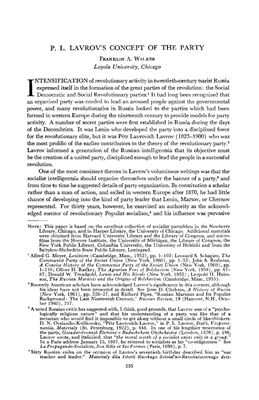Loyola University, Chicago, p. 235-250
Intensification of revolutionary activity in twentieth-century
tsarist Russia expressed itself in the formation of the great parties
of the revolution: the Social Democratic and Social Revolutionary
parties.’ It had long been recognized that an organized party was
needed to lead an aroused people against the govemental power,
and many revolutionaries in Russia looked to the parties which had
been formed in weste Europe during the nineteenth century to
provide models for party activity. A number of secret parties were
first established in Russia during the days of the Decembrists. It was
Lenin who developed the party into a disciplined force for the
revolutionary elite, but it was P6tr Lavrovich Lavrov (1823-1900)
who was the most prolific of the earlier contributors to the theory
of the revolutionary party. Lavrov informed a generation of the
Russian intelligentsia that its objective must be the creation of a
united party, disciplined enough to lead the people in a successful
revolution.
Intensification of revolutionary activity in twentieth-century
tsarist Russia expressed itself in the formation of the great parties
of the revolution: the Social Democratic and Social Revolutionary
parties.’ It had long been recognized that an organized party was
needed to lead an aroused people against the govemental power,
and many revolutionaries in Russia looked to the parties which had
been formed in weste Europe during the nineteenth century to
provide models for party activity. A number of secret parties were
first established in Russia during the days of the Decembrists. It was
Lenin who developed the party into a disciplined force for the
revolutionary elite, but it was P6tr Lavrovich Lavrov (1823-1900)
who was the most prolific of the earlier contributors to the theory
of the revolutionary party. Lavrov informed a generation of the
Russian intelligentsia that its objective must be the creation of a
united party, disciplined enough to lead the people in a successful
revolution.

